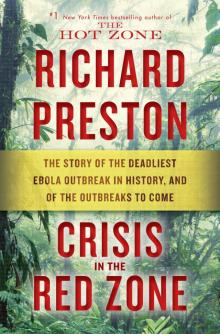- Home
- Richard Preston
Crisis in the Red Zone Page 6
Crisis in the Red Zone Read online
Page 6
Hensley went through a second checkpoint and into the IRF, and she walked down a corridor to her office. Her office had a new-carpet smell. She’d taped to the door a colorful drawing of a giraffe done by James. She sat down at her desk and began reviewing the day’s tasks. Meetings. Staff organization. Research programs, how to structure them, what to investigate. Budgets. Lab safety. The IRF’s Level 4 labs hadn’t yet gone into use—the space-suit labs were still awaiting safety certification by federal inspectors. That is, the IRF was still a cold facility, and it hadn’t yet gone hot. The IRF would only go hot after its Level 4 labs had passed all their safety inspections. At that point, small frozen vials of Level 4 pathogens would be brought into the facility and placed in ultra-low-temperature superfreezers inside the IRF’s Level 4 labs. The labs would then be hot, and the IRF would be a “supermax” prison for some of the fiercest life forms in nature.
As she worked on her email, Hensley couldn’t stop thinking about Ebola. For sixteen years, she had been trying to find a cure for Ebola virus disease. There was no cure. No vaccine, either. No drug, no treatment, no nothing. Every time Ebola broke out it thrust doctors back into the Middle Ages. The only way to cut off an Ebola outbreak was to put people in quarantine camps, where they died like flies, as if they were in a fourteenth-century plague house. About the best doctors could do for Ebola patients was to give them water and hope for the best.
* * *
—
When Lisa Hensley was a junior in college, studying public health at Johns Hopkins University, she began thinking about the human immunodeficiency virus, HIV. The most recent evidence suggests that the most common type of HIV made a cross-species jump out of one chimpanzee into one person around 1910 in southeastern Cameroon, along a tributary of the Congo River. From that first human host, HIV began spreading from person to person, amplifying itself in the human species until it reached every community on earth. As of this writing, some seventy million people have been infected with HIV and thirty-five million have died of AIDS. As she describes it, Hensley had a sudden flash of conviction, as a college student, that emerging viruses were going to become the single greatest threat to human health in her lifetime. Right then, she decided to become a scientist and to search for ways to stop them just as they were coming out of the ecosystem, before one of them scored a hit on the human species. “Imagine if we had gotten ahead of the curve with HIV,” she says, now. “Imagine if we had blood testing in place soon after it was discovered. Countless lives could have been saved. I wanted to do something about the next HIV.”
In 1996, after getting a master’s degree in public health and a PhD in molecular biology, Hensley got a job at the United States Army Medical Research Institute of Infectious Diseases, or USAMRIID (pronounced “you-SAM-rid”), at Fort Detrick. The main structure at USAMRIID is a vast, nearly windowless biocontainment block, built in the late 1960s and filled with a warren of hot zones. Today, USAMRIID is part of the National Interagency Biodefense Campus at Fort Detrick; it is the oldest facility on the campus. When she started working at USAMRIID, Hensley had no knowledge of space suits and no interest in working in a hot zone; she planned to do research on a mild virus that causes common colds, especially in children. This kind of cold virus infects many kinds of wild animals. Hensley thought that one of the wild cold viruses could jump out of an animal into a person somewhere on earth and start a global outbreak of a fatal, emerging cold.
The common cold seemed exciting to Lisa Hensley, but it wasn’t very exciting to a colonel at USAMRIID named Nancy Jaax, who is an expert on Ebola virus. One day, after Hensley had been working at USAMRIID for about a year, Jaax asked Hensley if she could talk with her privately for a moment. “Nancy pulled me into her office and said, ‘You’re going to work with Ebola now,’ ” Hensley says. Hensley sensed that Colonel Jaax wasn’t really offering her a choice.
Nancy Jaax and other Ebola researchers trained Hensley in the protocols of Level 4: putting on and taking off a pressurized biohazard space suit, passing through airlocks, and using a decon shower to sterilize the outside of the suit. Situational awareness—knowing exactly where your hands are at every moment. Handling needles and sharp instruments with extreme care. Hensley loved working in Level 4. Doing research in hot labs became almost an addiction for her, and she became fascinated with Ebola virus. It was really something to hold a flask containing a liquid suspension of ten billion particles of Ebola in her gloved hands inches from her space suit’s clear faceplate visor. You always had to wonder what this virus could do to the human species if it got a big chance to amplify itself in human bodies.
Most medical investigators have zero interest in doing space-suit research on Level 4 viruses. Work in a biohazard space suit is physically exhausting and dangerous. It requires total concentration, and simple tasks take much longer to accomplish. And if you get a pinhole in your space suit and don’t notice, a few particles of a Level 4 virus could slip inside and get friendly with you, and you wouldn’t know what had happened until you started throwing up blood.
Lisa Hensley did research on virtually every experimental drug and vaccine that might conceivably stop or slow down an Ebola infection in the human body. She focused her work on a species of the virus named Zaire Ebola. Zaire was the first Ebola to be discovered, when it broke out in 1976 at Yambuku Catholic Mission in Yambuku, Zaire.
At this writing there are six known species of Ebola. The six Ebola sisters. In order of discovery, the six Ebolas are named Zaire Ebola, Sudan Ebola, Reston Ebola, Taï Forest Ebola, Bundibugyo Ebola, and Bombali Ebola. Each species of Ebola has its own identifiable genetic code and is somewhat different from the others. Zaire is the most lethal of the six Ebolas; it is the homicidal elder sister. In the 1976 outbreak, Zaire Ebola killed 88 percent of its victims, though in subsequent outbreaks it killed roughly 60 to 70 percent. Zaire Ebola is not only the most deadly of the five Ebolas, it is also the most deadly of all the known filoviruses, the family of viruses that includes the Ebolas. Zaire Ebola is the lord of the strains.
Lisa Hensley branched out into research on other emerging viruses. Her targets included Sars virus and Mers virus, which are lethal Biosafety Level 3 agents that circulate in animals and can invade people—and in fact these viruses are the animal cold viruses that Hensley feared, and they do cause extremely lethal cold-like illnesses in humans. Sars and Mers are contagious and can mutate very fast. Hensley studied Level 4 hot agents: Hendra virus, Lassa virus, monkeypox, Lake Victoria Marburg filovirus, and the Ravn filovirus. Ravn virus was first isolated from the blood of a ten-year-old Danish boy known as Peter Cardinal, who died of Ravn disease after possibly getting infected inside Kitum Cave, a bat cave on the slopes of Mount Elgon in Kenya. The Ravn virus has been found exactly nowhere except in the blood of the Danish boy—he is the only individual who is known to have been infected with Ravn. Still, Ravn could break into the human species again from its hidden reservoir in nature. Hensley also did research on a Level 4 emerging virus called Nipah. Nipah is a bat virus that causes personality changes and liquefaction of the brain. Nipah is only moderately infectious, but it gets into the lungs, and there is a certain alarm among experts that the code of the virus could change and turn the virus into a sort of brain-destructive neurological cough that travels in the air. There is no vaccine or treatment for Nipah disease.
Hensley also got involved with the smallpox virus. Smallpox, which was arguably the worst disease in human history, was declared eradicated in 1979. However, stocks of smallpox virus may exist in clandestine military laboratories of certain nations, including Russia and North Korea. Poxviruses such as smallpox are among the easiest viruses to modify with genetic engineering. Hensley and her colleagues had done research toward drugs that might protect the population from a genetically engineered superpox. Hensley had published 110 scientific papers, most of them involving medical countermeasures to emerging lethal viruses. Eventually s
he became the chief of research into antiviral drugs and vaccines at USAMRIID. Although she had risen to prominence, at least in the small, largely unseen world of people who work on defenses against the most dangerous elements of the virosphere, Hensley had no illusions about her importance as a scientist or a person. Biomedical research is done by teams. The research is time-consuming and deeply expensive, and the results are often disappointing. With persistence, talent, and luck, and plenty of money, a biomedical research team can sometimes pull the veil off some small mystery of nature and the human body, and can find a better way to treat a disease.
As the years went by, Ebola virus remained Lisa Hensley’s oldest, most seductive enemy. She dreamed of finding a medical weapon that would stop the virus’s growing entanglement with the human species. Angels used their swords to kill demons. In effect, the Ebola scientists hoped to find an angel’s sword that would vanquish Ebola, slay it—a drug that could pierce Ebola’s half-dead heart and make it die a permanent death. So far, there was no such thing as an angel’s sword to kill Ebola. Now, in her office at the Integrated Research Facility, Hensley decided to wait until there was an official confirmation. She turned her attention to paperwork that morning, but she couldn’t stop thinking about the fact that people were dying with hiccups.
INTEGRATED RESEARCH FACILITY
9 a.m., March 23, 2014
The French and German teams soon nailed down the exact identity of the filovirus in West Africa. On March 23, the World Health Organization announced that it was, indeed, Ebola: “A rapidly evolving outbreak of Ebola virus disease (EVD) in forested areas of southeastern Guinea. As of 22 March, 2014, a total of 49 cases including 29 deaths (case fatality ratio: 59%) had been reported.”
After Lisa Hensley arrived at work and caught up on a little bit of email, she went down the hallway to the office of the director of the IRF, a virologist named Peter B. Jahrling. Jahrling is an expert in space-suit research, is a specialist in Lassa virus, and is the co-discoverer of Reston Ebola. He has a seamed face, a brush of gray hair, and looks as you’d expect a scientist might. He wears metal-rimmed eyeglasses, and often a grayish jacket with a subdued necktie in lighter tones of blue. Lisa Hensley had worked for Peter Jahrling for sixteen years at USAMRIID: They knew each other well.
Jahrling turned away from his computer. “Hey Lisa. What’s up?”
“So it’s Ebola,” she said.
“Well, yeah. It was pretty surprising.”
“Shouldn’t we be involved, sir?”
Jahrling gave her an uncomfortable look. “How should we be involved?”
The IRF could put together a field team, she suggested. An away team. We could send the team to West Africa, she said to Jahrling, and try to save some lives. “I’ll go myself, sir,” she said. Meaning she would lead the team.
“I’m not in favor of you going to West Africa right now,” Jahrling answered. The Integrated Research Facility was a lab. Staffed by…well…lab types. Young. Ambitious. Deft with pipettes and tiny vials of liquid. Stereotypable as nerds, though actually they were scientific hotshots. But to send an away team to Africa to fight a filovirus was a job for the Centers for Disease Control, not the IRF. And the IRF was in the middle of startup operations. Jahrling did not want his director of research suddenly flying off to Africa, taking staff with her.
Jahrling obviously had a strong point. Hensley couldn’t really argue with him—objectively he was right. And she had James to think about. She was a single mother, and if she went to Africa to help people deal with Ebola, she wouldn’t be with her son. One issue was his hemophilia. It was mild but a little unpredictable. One day he would take a tumble and he’d be fine, then another day he’d scrape his knee on the playground and it wouldn’t stop oozing. James seemed to enjoy freaking out his teachers with a drippy cut. Hensley would get a panicky call from his school saying he’d cut himself and needed to be picked up. She’d take him home and watch his cut, and sometimes it would heal and sometimes it wouldn’t. If it was still oozing, she would drive him to Johns Hopkins Hospital in Baltimore, where his doctors would give him clotting factor, and he’d heal immediately. The trips to Johns Hopkins were infrequent but unpredictable. As his mother, she felt she should be there for him. On the other hand, people were dying, and she was one of the few people in the world who knew much about filoviruses like Ebola.
Hensley went back to her office, feeling slightly less than completely useful. It had been more than a year since she’d put on a space suit and gotten her hands on a Level 4 virus. Her talent and accomplishments in the lab had led to a promotion into management. She had wanted to manage large research projects, of course. Now she did meetings all day, and collected a much bigger government salary. And still there was no vaccine or treatment for any filovirus, including Ebola. Nor was there a vaccine or medical countermeasure against other viruses that seemed ready for a breakthrough into the human species: Sars, Mers, Nipah. She wanted to go straight up against an emerging virus at the gates of the ecosystem, just as it jumped out of the virosphere and began to move into humans. She wanted to help people, try to save some lives, if she could. And the fact was, she missed her space suit.
The news came as a surprise to Ebola experts. Ebola virus had never been seen before in this region of West Africa. And it was Zaire Ebola, the hottest of the six Ebolas. It was the Ebola that had visited Yambuku Catholic Mission in late 1976. The Makona Triangle was more than two thousand miles from Yambuku, where the virus had emerged, killed some people, and vanished. Thirty-seven years later, Zaire Ebola had come out of nowhere in West Africa and was sacking humans along the Makona River. It was the lord of the strains, back from the dead.
RED ZONE
BRUSSELS, BELGIUM
CONAKRY, GUINEA
March 23, 2014
At the time of the WHO announcement, managers at the Brussels operational center of Doctors Without Borders had already started to go into action, organizing for another fight with Ebola. Over the years, Doctors Without Borders had become the shock cavalry of the human response to Ebola whenever it broke out. Ebola had to be put down quickly before it spread far and claimed many lives. Now, Doctors Without Borders began rushing medical supplies to Conakry, the capital of Guinea, and organizing teams of staffers and volunteers to go to the Makona Triangle and start putting down the virus.
Within days, people from Doctors Without Borders were setting up Ebola treatment units in Guéckédou and Macenta, the two small cities into which Ebola had now moved. A typical Ebola treatment unit of Doctors Without Borders is a collection of white plastic tents where Ebola patients are placed in strict biocontainment isolation so they can’t infect other people. Patients are placed in cots in the tents, and tents are set up at the center of the camp, in an area known as the red zone. The red zone is surrounded by a maze of plastic fences, to separate infected people from everybody else. As long as a patient’s blood tests are positive for Ebola, the patient isn’t allowed to leave the red zone. Patients die in the red zone; they are not permitted to die anywhere else. When staffers exit the red zone, workers spray them with bleach before they take off their equipment, to sterilize it and kill any Ebola particles that are clinging to the gear. An Ebola patient who recovers is discharged from the red zone and allowed to go home. The bodies of patients who die in the red zone are placed inside double body bags, and are buried close to the camp. The red zone has pit toilets that are inside plastic sheds. There is a laboratory tent, where blood is tested, and there are generators to supply electricity.
The red zones of Doctors Without Border were, in effect, giant plastic bags in which people infected with emergent Ebola were kept. This technique trapped the virus inside the plastic bag, where it would work its way through the human bodies in the bag, killing many of them—but the virus couldn’t escape from the bag. The red zones were artificial walls placed around hot spots of Ebola in order to break
the growing chains of infection in the human species.
Each time Ebola started spreading in humans, Doctors Without Borders moved in with teams and tents and snuffed out the virus. The teams of Doctors Without Borders were very much like forest firefighters jumping into hot spots and putting down blazes while they are small. In the years since Ebola’s first appearance, in 1976, there had been nineteen outbreaks of Ebola, and very few people had caught the virus. Never more than 280 people had died in any Ebola outbreak. In thirty-seven years of outbreaks, the six different Ebolas had killed, in all, only 1,539 people, according to reported deaths. The death toll from Ebola was virtually nothing in the annals of infectious disease: Each year, tuberculosis kills around 1.3 million people. Over the years, as Doctors Without Borders slammed down Ebola successfully, a widespread view developed among public health experts that Ebola wasn’t much of a problem for the human population of the world and never would be. It is fair to say, however, that nature often does whatever is necessary in order to make the most number of experts wrong.
THE DOCTOR
KENEMA GOVERNMENT HOSPITAL
5 a.m., March 24, 2014
The morning after the World Health Organization announced that Ebola had emerged in West Africa, Dr. Humarr Khan, the head of the Lassa research program at Kenema Government Hospital, in the city of Kenema, Sierra Leone, got up before dawn, as usual. Khan lived in a rented house on Sombo Street in downtown Kenema. That morning, he put on dark slacks and a short-sleeved shirt. He stuffed a wad of paper currency into his pocket, and he performed the dawn prayer on his prayer rug.

 The Demon in the Freezer
The Demon in the Freezer Panic in Level 4: Cannibals, Killer Viruses, and Other Journeys to the Edge of Science
Panic in Level 4: Cannibals, Killer Viruses, and Other Journeys to the Edge of Science The Cobra Event
The Cobra Event The Hot Zone
The Hot Zone Crisis in the Red Zone
Crisis in the Red Zone First Light: The Search for the Edge of the Universe
First Light: The Search for the Edge of the Universe The Book of the Dead
The Book of the Dead Panic in Level 4
Panic in Level 4